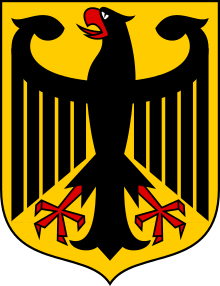Energy in Germany
Energy in Germany is sourced predominantly by fossil fuels, followed by wind, nuclear power, solar, biomass (wood and biofuels) and hydro.

.png)
The German economy is large and developed, ranking fourth in the world by GDP. Germany is sixth in global energy consumption between 2004 and 2007.[1] Germany was Europe's largest consumer of electricity in 2002; electricity consumption that year totaled 512.9 terawatt-hours. In 2013 Germany's electricity production reached 631.4 TWh.[2]
Key to Germany's energy policies and politics is the "Energiewende", meaning "energy turnaround" or "energy transformation". The policy includes phasing out nuclear power by 2022, and progressive replacement of fossil fuels by renewables. Operators have already closed plants ahead of their intended retirement dates.
Overview
| Population million |
Prim. energy TWh |
Production TWh |
Import TWh |
Electricity TWh |
CO2-emission Mt | |
|---|---|---|---|---|---|---|
| 2004 | 82.5 | 4,048 | 1,582 | 2,509 | 580 | 849 |
| 2007 | 82.3 | 3,853 | 1,594 | 2,344 | 591 | 798 |
| 2008 | 82.1 | 3,899 | 1,560 | 2,453 | 587 | 804 |
| 2009 | 81.9 | 3,705 | 1,478 | 2,360 | 555 | 750 |
| 2010 | 81.8 | 3,807 | 1,528 | 2,362 | 590 | 762 |
| 2012 | 81.8 | 3,626 | 1,444 | 2,315 | 579 | 748 |
| 2012R | 81.9 | 3,635 | 1,435 | 2,321 | 585 | 755 |
| 2013 | 82.1 | 3,694 | 1,400 | 2,411 | 576 | 760 |
| change 2004–2010 | −0.9% | −5.9% | −3.4% | −5.9% | 1.7% | −10.3% |
|
1 Mtoe = 11.63 TWh | ||||||
Energy consumption
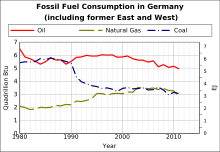
Germany is the sixth largest consumer of energy in the world,[4] and the largest national market of electricity in Europe. The country is the fifth-largest consumer of oil in the world. Oil consumption accounted for 34.3% of all energy use in 2018, and 23.7% of Germany's energy consumption came from gas.[5]
Germany imports more than half of its energy.[6] The country largely imports its oil from Russia, Norway and the United Kingdom.[7] Germany is also the world's largest importer of natural gas. The largest gas imports come from the Netherlands, Norway, and Russia via the Nord Stream. In 2016, Germany imported 49.8 billion cubic metres (bcm) of gas from Gazprom. [8] A terminal in Emden opened for gas from Norway in 2016.[9]
Because of its rich coal deposits, Germany has a long tradition of using coal. It is the fourth-largest consumer of coal in the world. Domestic coal mining has been almost completely phased out. This is because German coal is a lot more expensive to mine than importing coal from China or Australia.
Electricity production
- Nuclear: 71.09 TWh (13.8%)
- Brown Coal: 102.18 TWh (19.9%)
- Hard Coal: 48.69 TWh (9.5%)
- Natural Gas: 54.05 TWh (10.5%)
- Wind: 127.22 TWh (24.8%)
- Solar: 46.54 TWh (9.1%)
- Biomass: 44.42 TWh (8.7%)
- Hydro: 19.23 TWh (3.7%)
.png)
Coal power

Coal is the largest source of electricity in Germany. As of 2016, around 40% of the electricity in the country is generated from coal.[11] This was slightly down from 2013, when coal made up about 45% of Germany's electricity production (19% from hard coal and 26% from lignite).[12]
Germany is also a major producer of coal. Lignite is extracted in the extreme western and eastern parts of the country, mainly in Nordrhein-Westfalen, Sachsen and Brandenburg. Considerable amounts are burned in coal plants near the mining areas to produce electricity and transporting lignite over far distances is not economically feasible; therefore, the plants are located near the extraction sites.[13] Bituminous coal is mined in Nordrhein-Westfalen and Saarland. Most power plants burning bituminous coal operate on imported material, therefore, the plants are located not only near to the mining sites, but throughout the country.[13]
German coal-fired power plants are being designed and modified so they can be increasingly flexible to support the fluctuations resulting from increased renewable energy. Existing power plants in Germany are designed to operate flexibly. Load following is achieved by German natural gas combined cycle plants and coal-fired power plants. New coal-fired power plants have a minimum load capability of approximately 40%, with further potential to reduce this to 20–25%. The reason is that the output of the coal boiler is controlled via direct fuel combustion and not, as is the case with a gas combined-cycle power plant, via a heat recovery steam generator with an upstream gas turbine.[12]
Germany has been opening new coal power plants until recently, following a 2007 plan to build 26 new coal plants.[14] This has been controversial in light of Germany's commitment to curbing carbon emissions.[15] By 2015, the growing share of renewable energy in the national electricity market (26% in 2014, up from 4% in 1990) and the government's mandated CO2 emission reduction targets (40% below 1990 levels by 2020; 80% below 1990 levels by 2050) have increasingly curtailed previous plans for new, expanded coal power capacity.[16][17]
On 26 January 2019, a group of federal and state leaders as well as industry representatives, environmentalists, and scientists made an agreement to close all 84 coal plants in the country by 2038. The move is projected to cost €40 billion in compensation alone to closed businesses. Coal was used to generate almost 40% of the country's electricity in 2018 and is expected to be replaced by renewable energy. 24 coal plants are planned to be closed by 2022 with all but 8 closed by 2030. The final date is expected to be assessed every 3 years.[18]
In 2019 import of coal raised by 1.4% compared to 2018.[19]
Nuclear power
Nuclear power has been a topical political issue in recent decades, with continuing debates about when the technology should be phased out. A coalition government of Gerhard Schroeder took the decision in 2002 to phaseout all nuclear power by 2022.[20][21] The topic received renewed attention at the start of 2007 due to the political impact of the Russia-Belarus energy dispute and in 2011 after the Fukushima I nuclear accidents in Japan.[22] Within days of the March 2011 Fukushima Daiichi nuclear disaster, large anti-nuclear protests occurred in Germany. Protests continued and, on 29 May 2011, Merkel's government announced that it would close all of its nuclear power plants by 2022.[23][24] Eight of the seventeen operating reactors in Germany were permanently shut down following Fukushima in 2011. German coal consumption has risen during 2011, 2012 and 2013.[25]
Chancellor Angela Merkel said the phase-out of plants, previously scheduled to go offline as late as 2036, would give Germany a competitive advantage in the renewable energy era, stating, "As the first big industrialized nation, we can achieve such a transformation toward efficient and renewable energies, with all the opportunities that brings for exports, developing new technologies and jobs". Merkel also pointed to Japan's "helplessness" – despite being an industrialized, technologically advanced nation – in the face of its nuclear disaster.[26]
In September 2011, German engineering giant Siemens announced a complete withdrawal from the nuclear industry, as a response to the Fukushima nuclear disaster.[27][28] Remaining nuclear companies in Germany are E.ON Kernkraft GmbH, Vattenfall Europe Nuclear Energy GmbH, RWE Power AG, and EnBW Energie Baden-Wuerttemberg AG.
Renewable energy
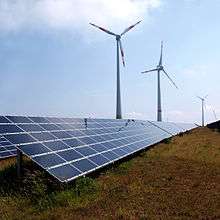
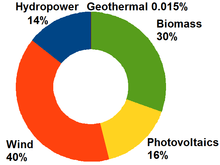
The share of electricity produced from renewable energy in Germany has increased from 6.3 percent of the national total in 2000 to over 25 percent in the first half of 2012.[29] Germany renewable power market grew from 0.8 million residential customers in 2006 to 4.9 million in 2012, or 12.5% of all private households in the country. In 2011, they purchased 15 terawatt-hours (TWh) of green power, and commercial customers bought a further 10.3 TWh.[30] Renewable energy share of gross electricity consumption rose from 10% in 2005 to 20% in 2011. Main renewable electricity sources were in first half of 2012: Wind energy 36.6%, biomass 22.5%, hydropower 14.7%, photovoltaics (solar) 21.2% and biowaste 3.6%.[31] Wood-fire plants fuelled by wood pellets are included in biomass. Half of Germany's timber production is consumed by wood fired plants. Wood fired plants are counted as renewable energy by Germany and the European Union counting them as "carbon neutral".[32]
In 2010, investments totaling 26 billion euros were made in Germany’s renewable energies sector. Germany spends about 20 billion euros per year subsidizing renewable energy.[33] According to official figures, some 370,000 people in Germany were employed in the renewable energy sector in 2010, especially in small and medium-sized companies. This is an increase of around 8 percent compared to 2009 (around 339,500 jobs), and well over twice the number of jobs in 2004 (160,500). About two-thirds of these jobs are attributed to the Renewable Energy Sources Act[34][35]
In the first half of 2012 25.1% of Germany's electricity supply was produced from renewable energy sources, more than the electricity generated by nuclear power stations.
In end of 2011, the cumulative installed total of renewable power was 65.7GW.[36] Although Germany does not really have a very sunny climate, solar photovoltaic power is used massively (4% of annual electricity needs). On 25 May 2012, a Saturday, solar power reached a new record with feeding 22 GW, as much as can be produced by 20 nuclear reactors, into the German power grid. This met 50% of the nation's mid-day electricity demand on that day.[37]
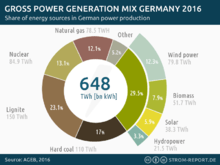
In 2016 renewable energy based electricity generation reached 29.5%. Renewables are an important energy source in Germany but coal remains a factor at 40.1% of total generation. Wind was the leading source at 12.3%, followed by biomass at 7.9% and solar PV at 5.9%.[38]
 |
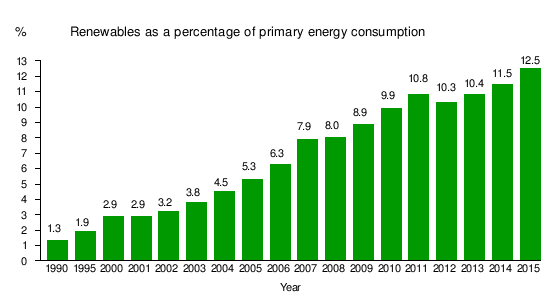
|
Bioenergy
In October 2016 the German Biomass Research Center (Deutsches Biomasseforschungszentrum) (DBFZ) launched an online biomass atlas for researchers, investors and the interested public.[40][41]
Energy efficiency
The energy efficiency bottom-up index for the whole economy (ODEX) in Germany decreased by 18% between 1991–2006, which is equivalent to an energy efficiency improvement by 1.2% per annum on average based on the ODEX, which calculates technical efficiency improvements. Since the beginning of the new century, however, the efficiency improvement measured by the ODEX has slowed down. While a continuous decrease by 1.5%/y could be observed between 1991 and 2001, the decrease in the period from 2001 to 2006 only amounted to 0.5%, which is below the EU-27 level.[42]

By 2050 Germany projects a 25% drop in electricity demand.
Government energy policy
Germany is the fourth-largest producer of nuclear power in the world, but in 2000, the government and the German nuclear power industry agreed to phase out all nuclear power plants by 2021,[43] as a result of an initiative with a vote result of 513 Yes, 79 No and 8 Empty. The seven oldest reactors were permanently closed after the Fukushima accident.[44] However, being an integral part of the EU's internal electricity market, Germany will continue to consume foreign nuclear electricity even after 2022.[45] In September 2010, Merkel's government reached a late-night deal which would see the country's 17 nuclear plants run, on average, 12 years longer than planned, with some remaining in production until well into the 2030s.[46] Then, following Fukushima Daiichi nuclear disaster, the government changed its mind again, deciding to proceed with the plan to close all nuclear plants in the country by 2022.[47]
Government policy emphasizes conservation and the development of renewable sources, such as solar, wind, biomass, water, and geothermal power. As a result of energy saving measures, energy efficiency (the amount of energy required to produce a unit of gross domestic product) has been improving since the beginning of the 1970s. The government has set the goal of meeting 80% of the country's energy demands from alternative energy by 2050.
After becoming Chancellor of Germany, Angela Merkel expressed concern for overreliance on Russian energy, but she received little support from others in Berlin.[48]
| Gas oil (>50 mg/kg sulfur) | Gas oil(≤50 mg/kg sulfur) | Heavy oil | Other oils | Natural Gas | Liquefied petroleum gas | |
|---|---|---|---|---|---|---|
| unit | €/liter | €/liter | €/kg | €/liter | €/MWh | €/tonne |
| Taxation | 0.7635 | 0.6135 | 0.25 | 0.6135 | 5.50 | 60.60 |
Sustainable energy
In September 2010, the German government announced a new aggressive energy policy with the following targets:[50]
- Reducing CO2 emissions 40% below 1990 levels by 2020 and 80% below 1990 levels by 2050
- Increasing the relative share of renewable energy in gross energy consumption to 18% by 2020, 30% by 2030 and 60% by 2050
- Increasing the relative share of renewable energy in gross electrical consumption to 35% by 2020 and 80% by 2050
- Increasing the national energy efficiency by cutting electrical consumption 50% below 2008 levels by 2050
Forbes ranked German Aloys Wobben ($3B), founder of Enercon, as the richest person in the energy business (wind power) in Germany in 2013.[51]
See also
| Wikimedia Commons has media related to Energy in Germany. |
- Electricity sector in Germany
- Energy transition in Germany, also known as the Energiewende
- German Renewable Energy Sources Act, also known as the Erneuerbare-Energien-Gesetz
- Renewable energy in Germany
- Economy of Germany
References
- US Energy Information Administration. "International Energy Statistics". Archived from the original on 8 January 2010. Retrieved 8 January 2013.
- "Bruttostromerzeugung in Deutschland von 1990 bis 2013 nach Energieträgern" (PDF). Ag-energiebilanzen.de. Retrieved 29 December 2017.
- IEA Key World Energy Statistics Statistics 2015, 2014 (2012R as in November 2015 + 2012 as in March 2014 is comparable to previous years statistical calculation criteria, 2013, 2012, 2011, 2010, 2009 Archived 7 October 2013 at the Wayback Machine, 2006 Archived 12 October 2009 at the Wayback Machine IEA October, crude oil p.11, coal p. 13 gas p. 15
- "Free publications" (PDF). Iea.org. Retrieved 29 December 2017.
- "Germany's dependence on imported fossil fuels". Clean Energy Wire. 22 June 2015. Retrieved 24 April 2018.
- "Infografic: Can Germany's Energiewende ensure supply?". euractive.com. Retrieved 1 February 2017.
- Archived 1 July 2008 at the Wayback Machine
- "Gazprom says exports to Germany hit record high in 2016". EurActiv.com. 17 January 2017. Retrieved 1 February 2017.
- "New German terminal for Norwegian gas". Euro-petrole.com. Retrieved 24 May 2016.
- Burger, Bruno (15 January 2020). Public Net Electricity Generation in Germany 2019 (pdf). ise.fraunhofer.de. Freiburg, Germany: Fraunhofer Institute for Solar Energy Systems ISE. Retrieved 2 February 2020.
- Girl, Energy. "Renewable Energy Germany - German Energy Transition". Strom-report.de. Retrieved 29 December 2017.
- "The Flexibility of German Coal-Fired Power Plants Amid Increased Renewables". Cornerstonemag.net. Retrieved 29 December 2017.
- Gürtler, Detlef: Wirtschaftsatlas Deutschland. Rowohlt Berlin, 2010.
- "Germany Plans Boom in Coal Power Plants". Bloomberg.com. 21 March 2007. Retrieved 29 December 2017.
- "US". Independent.co.uk. Retrieved 29 December 2017.
- "Germany to mothball largest coal power plants to meet climate targets". The Guardian. 2 July 2015. Retrieved 17 August 2015.
- Christian Schwägerl (5 August 2015). "Green and brown clash as Germany struggles to end coal". GreenBiz.com. Retrieved 17 August 2015.
- Technica, Ars (28 January 2019). "It'll cost $45 billion, but Germany proposes to eliminate coal in 19 years". Ars Technica. Retrieved 29 January 2019.
- "Germany's 2019 hard coal imports seen rising after mining ends". reuters.com. Retrieved 18 January 2019.
- "The history behind Germany's nuclear phase-out". Cleanenergywire.org. Retrieved 17 August 2015.
- "Germany renounces nuclear power". BBC. 15 June 2000. Retrieved 17 August 2015.
- "Germany: Nuclear power plants to close by 2022". BBC. 30 May 2011. Retrieved 30 May 2011.
- Caroline Jorant (July 2011). "The implications of Fukushima: The European perspective". Bulletin of the Atomic Scientists. p. 15.
- Knight, Ben (15 March 2011). "Merkel shuts down seven nuclear reactors". Deutsche Welle. Retrieved 15 March 2011.
- Archived 24 July 2015 at the Wayback Machine
- Baetz, Juergen (30 May 2011). "Germany Decides to Abandon Nuclear Power by 2022". Associated Press. Retrieved 30 May 2011.
- John Broder (10 October 2011). "The Year of Peril and Promise in Energy Production". New York Times.
- "Siemens to quit nuclear industry". BBC News. 18 September 2011.
- "Electricity – Renewable Energies in the first half of 2012" (PDF). Bdew.de. BDEW. Archived from the original (PDF) on 10 October 2012. Retrieved 28 December 2017.
- "Renewables 2014 Global Status Report, page 27" (PDF). Ren21.net. Retrieved 28 December 2017.
- Archived 10 October 2012 at the Wayback Machine
- "The fuel of the future". The Economist. 6 April 2013.
- Stefan Nicola. "Four Lessons Obama Should Learn From Merkel's Energy Revolution". Bloomberg.com. Retrieved 29 December 2017.
- "Renewable Energy Sources in Figures – National and International Development" (PDF). Erneuerbare-energien.de. Archived from the original (PDF) on 2 March 2012. Retrieved 28 December 2017.
- "Germany Leads Way on Renewables, Sets 45% Target by 2030 - Worldwatch Institute". Worldwatch.org. Archived from the original on 9 December 2018. Retrieved 29 December 2017.
- Archived 8 April 2011 at the Wayback Machine
- "Germany sets new solar power record, institute says". Reuters. 26 May 2012.
- "Germany's Power Generation Mix 2016". Strom-Report. 13 February 2017.
- "BMWi - Erneuerbare Energien - Zeitreihen Erneuerbare Energien" [BMWi - Renewable Energy - Renewable Energy Time Series]. Erneuerbare Energien (in German). Table 2. Retrieved 6 December 2016.
- "Online biomass atlas". Clean Energy Wire (CLEW). Berlin, Germany. 17 October 2016. Retrieved 8 November 2016.
- "Bioenergiedaten: Potenziale" [Bioenergy data: potentials]. Deutsches Biomasseforschungszentrum (DBFZ) (in German). Leipzig, Germany. Retrieved 8 November 2016.
- "Energy Efficiency Trends & Policies - ODYSSEE-MURE". Odyssee-indicators.org. Retrieved 29 December 2017.
- "Germany split over green energy". News.bbc.co.uk. 25 February 2005. Retrieved 29 December 2017.
- "Energiewende: Bundestag besiegelt den Atomausstieg". Zeit.de. 30 June 2011. Retrieved 29 December 2017.
- Severin Fischer/Oliver Geden (2011), Europeanising the German energy transition, SWP Comments 55
- German Energy Blog Government Adopts Energy Concept Archived 26 April 2015 at the Wayback Machine
- "Germany: Nuclear power plants to close by 2022". BBC News. 30 May 2011.
- Dependence on Russian gas worries some – but not all – European countries David Francis, The Christian Science Monitor, 6 March 2008
- Federal Ministry of Justice and Consumer Protection. "§2 of the "Energy-Taxation-Law" (EnergieStrG)". Retrieved 6 May 2019.
- Archived 14 December 2010 at the Wayback Machine
- "Aloys Wobben". Forbes.com. Retrieved 29 December 2017.
External links
- Electricity/Heat in Germany in 2005 from the International Energy Agency
- Statistical Energy Yearbook, 2012 from Enerdata

